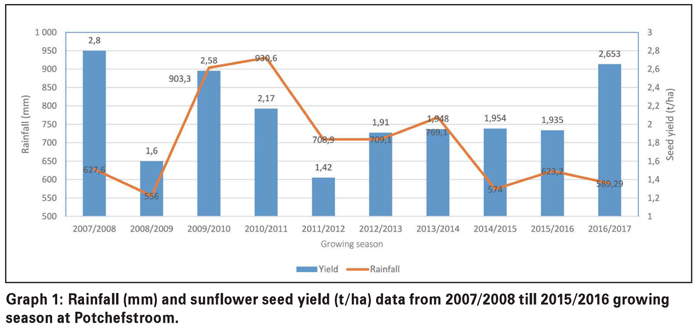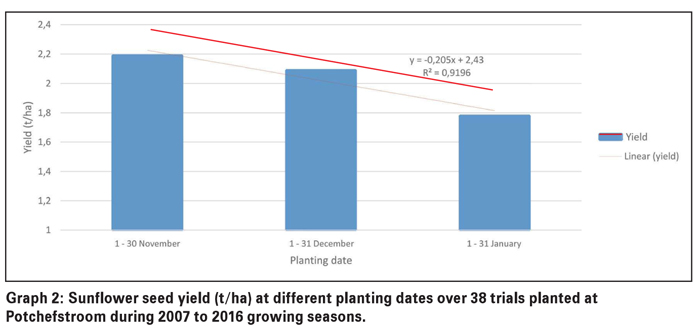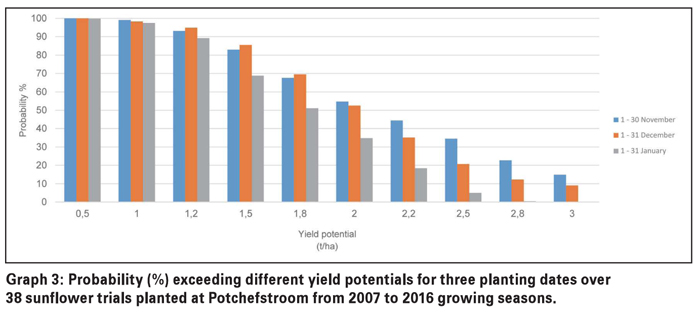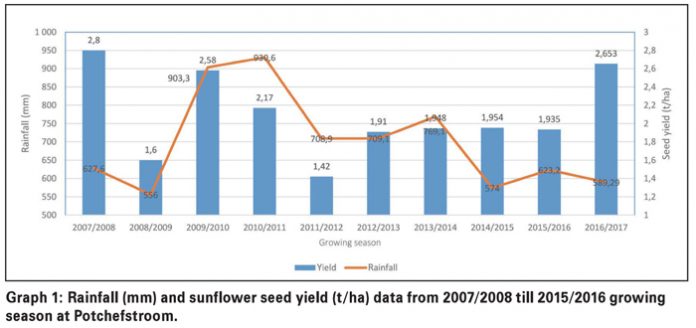December 2017
Dr Safiah Ma’ali, ARC-Grain Crops, Potchefstroom
Sunflower is classified as the third largest grain crop produced in South Africa after maize and wheat. According to the Crop Estimates Committee 2016/2017, the production forecast for sunflower is 821 970 tons. Sunflower is primarily used for the manufacturing of sunflower oil for human consumption and oil cake for animal feed.
Over the years, sunflowers have received the status of an ideal crop to grow in South Africa under conditions of low-input farming and marginal cropping conditions. It produces relatively consistent yields under adverse weather conditions and their overall characteristic of drought-tolerance makes it an attractive crop for producers in dryland production regions.
Sunflower is particularly efficient in extracting water from the soil profile, especially in sandy loam soils. Accordingly, it tolerates drier conditions better than other crops and explains the surprising yields achieved by producers in the drought stricken regions during the 2014/2015 growing season.
Unlike other grain crop alternatives, sunflower has a relatively long period, or ‘window,’ of possible planting dates, extending from the first of November to late January. The yield components of sunflower, heads per hectare, seeds per head, and weight per seed, are determined during different periods of growth.
The prevailing environmental conditions during these growth stages thus ultimately determine yield. To better understand the effect of planting date on yield, however, sunflower development can be simplified into three growth stages:
• Planting to floral initiation (GS1)
• Floral initiation to bloom (GS2)
• Bloom to physiological maturity (GS3)
Growth stage 1 (GS1)
This growth stage begins when the seed is planted and ends when floral parts of the sunflower are initiated. Floral initiation cannot be directly observed, but occurs between the ten to 14 leaf stage or approximately two-thirds of the way through the period from planting to bloom.
Comparing the three growth stages, sunflower in GS1 is the most delicate and sensitive to stress, yet if stress occurs it has
the least effect upon yield. The plant must only remain alive to maintain the yield component of heads per hectare.
Growth stage 2 (GS2)
Although the beginning of this growth stage is not readily recognisable, it represents an important event determining the final yield. The floral parts, which later become the harvested seeds, are formed during this stage. After the seeds are initiated, they expand to form the visible bud and eventually the sunflower head, which blooms and completes GS2. The head size, or the number of seeds per head is established during this stage.
Any stress that limits the growth rate during GS2 will be reflected in a reduced number of seeds per head. Drought stress during this stage reduces yield more than any other phase of sunflower development.
 Growth stage 3 (GS3)
Growth stage 3 (GS3)
The final stage of development begins when flowering is completed and ends at physiological maturity. During GS3, seed size or weight per seed is determined. As physiological maturity approaches, sunflower is able to utilise progressively lower temperatures for seed growth, while also becoming increasingly tolerant for drought.
Stress during GS3 can reduce yield, but usually not to the extent of the reduction during GS2, since seed weight is relatively a smaller contributor to yield than seed number under most conditions.
Unfortunately, moisture is usually the most yield limiting factor. It is also difficult to predict when and how much precipitation will be received. Graph 1 illustrates long term seasonal averages. It should, however, be stated that such data and yield are most often unrelated.
Even moderate amounts of rainfall received at critical stages of growth, such as the first phase of GS2, can stimulate yield potential far beyond what a monthly total will induce. The trend evident in the precipitation averages, however, would suggest that
delayed planting further removes crop development from the months when rainfall is most expected.
Another factor, which affects sunflower stand, is poor germination due to excessive heat at the time of planting. Because sunflowers sometimes have to be planted in January, or even into early February, temperatures during this period often reach up to 32°C to 35°C. Temperatures in this range are not ideal for sunflower seed germination.
Even when seeds germinate, high temperatures may cause them to wither and die. Another risk factor is that top soil tends to dry out fast in the heat and therefore a producer is forced to plant the seeds a bit deeper where the soil moisture content is higher. Although this can be a solution, it is, unfortunately, a risky practise as one hard shower of rain after planting will cause a thick crust to form and the seedlings will be unlikely to emerge. Sunflowers can be a most rewarding crop and the market is reliable, but it is important to choose the planting time carefully and ensure a good plant population.
Planting dates
ARC-Grain Crops in Potchefstroom has been conducting research on planting dates since 2007 and have demonstrated profound effects upon sunflower growth and development. This summary of findings at ARC-Grain Crops illustrates the importance of planting date in producing maximum yields of sunflower.
For the past ten cropping seasons, seed yield from 38 national sunflower cultivar trials planted at Potchefstroom were evaluated under three different planting dates (1 to 30 November, 1 to 30 December and 1 to 30 January).
The results indicated that sunflower seed yield declined as planting dates were delayed (Graph 2). Seed yield was reduced by approximately 0,21 t/ha for each 30 days delay in planting date after November.

The yield probability percentages for different planting dates were subsequently calculated at different yield threshold ranges (0,5 t/ha to 3 t/ha). Results showed that the probability of getting higher yield under a specific yield threshold (>1,2 t/ha) was lower at late planting dates in comparison with November and December planting dates (Graph 3).
It means that sunflower planted later in the season will have a lower yield potential. It can be concluded that a higher yield might be achieved by planting during November and December rather than with a late planting, especially during January.

Producers who are looking to planting sunflower as a main and not as catch crop, should consider planting the crop during November and no later than end of December in order to reach the target yield of more than 2 t/ha.
Publication: December 2017
Section: On farm level


















